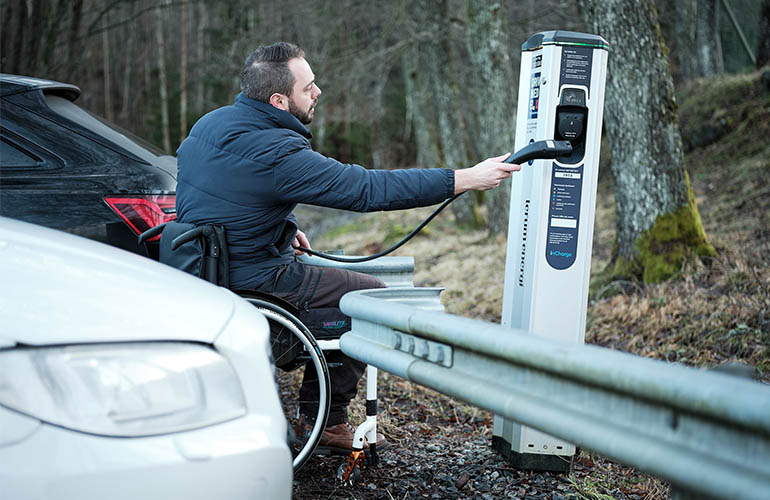
Disabled drivers often encounter fundamental difficulties when attempting to charge their vehicles. For that reason, we want to raise awareness about the design of charging stations. Ensuring that those responsible for setting up new stations are aware of the problems that disabled drivers may face.
The transformation of the personal transportation sector to all-electric vehicles is changing the auto industry fundamentally. The many advantages EVs offer to people with disabilities provide new forms of mobility. EVs often come without gears and with safety features that particularly help drivers with lesser maneuverability, features such as responsive steering wheels, lane keep assist, cruise control, and automatic safety braking.
Access to and around a car is crucial for someone with reduced mobility. For the charger at your home, you can choose a product according to your accessibility needs, but you can meet numerous challenges when using public charging stations. Unfortunately, these stations are often not yet designed for people with disabilities. Again and again, key accessibility requirements are missing, indicating poor planning or inadequate design. That is why for many, the use of electric cars stays off-limits.
What are the challenges?
The main issues that need to be addressed in all public charging site designs include:
- Safety and lighting
- Space at and around the charging station
- Curbs, curbstones, and other barriers around the charger
- The height of screens and handles
- Payment ease
- Cables
- The everyday usability of a charger
For someone with disabilities, both access and safety are essential. Certainly, if you are driving alone in a car, it is central to be able to move safely and freely in and around your vehicle. Because of security rules, public charging stations are often placed on a curb or embedded in physical barriers to prevent parking cars from damaging sites. For a person in a wheelchair or dependent on other mobility devices, these security measures can prove an additional barrier.
Widening parking areas is an overall benefit, but drivers don't just go out and into their vehicles. They also must access the chargers. A generous width is necessary to be able to turn around and operate a charging point. The able-bodied will have no trouble getting around in their cars. For somebody in a wheelchair, for instance, it can be quite difficult to get very close to a charging unit.
Even screens and paying systems are repeatedly installed in ways that can be challenging. The same is for charging cables and plugs, which can be hard to reach or handle. The weight, thickness, and limited manoeuvrability of cables can already be challenging for someone without disabilities. It seems rather useless for a driver who arrives at a charging site and is unable to lift the cable and connect it to the car.
What makes public charging accessible?
Enough space around a vehicle is important. Parking spaces in front of the chargers must be sufficient, which means significantly wider and longer than an ordinary parking space, so it is easy to drive around and move around. Charging stations must be located in well-lit and safe areas to ensure that users do not feel vulnerable or isolated during charging.
The roadway between the car and the charging point must be clear and unobstructed. Screens and displays must be positioned at accessible heights, and user information must be visible across all lighting and weather conditions. The equipment must be simple to use, with a method of payment that is universal and easy to access.
When used manually, just a very small amount of strength or force should be needed to maneuver the charging cable. Accessible chargers are those designed for ease of use, making the charging experience as simple and safe as possible for any user.
Accessibility that makes a difference
The path to accessible electromobility requires a joint effort, as pointed out by the European Mobility Group (EMG) summarizes in an article on the electrification of the automotive industry. Through a broad and inclusive approach, manufacturers of electric vehicles and charging stations, automotive conversion companies, representatives of disabled drivers, and decision-makers must work together.
We are still in the early stages of this transformation process and many charging sites have yet to be designed. That said, there is still a lot of time to make the new chargers accessible to persons with disabilities. What’s needed is inclusive planning and sustainable design concepts that combine the great knowledge of everyone involved. The charging of electric vehicles must be accessible to all. As a society, we cannot afford to exclude anybody from the electrification revolution, but we can create access that makes a difference.